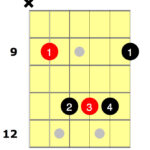Achieving that iconic, raw, and untamed guitar tone often described as “fire breathing” is a quest for many guitarists. While the term “Fire Breathing Guitar Movie” might evoke images of cinematic soundscapes, the real magic lies in the meticulous craft of tone shaping, often exemplified by legendary musicians like Neil Young. His distinctive guitar sound, raw and powerful, serves as a prime example of this sonic fire. To truly understand and replicate this kind of “fire breathing” tone, we need to delve into the specifics of gear, technique, and the subtle nuances that create such an explosive sound.
Unpacking the Legend: Neil Young’s “Old Black”
At the heart of Neil Young’s signature sound is his iconic “Old Black,” a heavily modified 1953 Gibson Les Paul Goldtop. This guitar is far from stock, bearing the scars and modifications of a lifetime of sonic exploration. Crucially, it features a Firebird mini-humbucker in the bridge position and a late metal-covered P90 neck pickup, likely sourced from a Gibson ES-330. This pickup combination alone contributes significantly to the unique tonal palette of “Old Black,” offering a blend of brightness and warmth that’s both aggressive and articulate.
Adding to the intrigue, “Old Black” is rumored to have had its neck replaced in the 1960s by Gibson with an SG Les Paul neck. This neck swap could subtly alter the guitar’s resonance and playability, further contributing to its unique character. However, perhaps the most critical modification, and what many believe to be the key to its explosive sound, is a mini toggle switch installed amongst the controls.
The Bypassed Pickups: The Secret Weapon
This unassuming toggle switch is the secret weapon behind the “fire breathing” tone. It bypasses the guitar’s volume and tone controls, sending the raw, unfiltered output of the pickups directly to the output jack. This direct signal path unleashes the full power and frequency range of the pickups, resulting in a hotter, more aggressive signal that pushes amplifiers into overdrive with unparalleled intensity. This is a crucial element in achieving that raw, untamed sound that many associate with a “fire breathing” guitar tone, reminiscent of what one might imagine hearing in a powerful guitar-driven movie scene.
Furthermore, looking at the back of “Old Black,” an aluminum disc beneath the bridge hints at another modification. Rumors suggest this might be a custom string-locking mechanism built by guitar tech Larry Cragg. Such a mechanism could enhance sustain and string stability, contributing to the guitar’s overall resonance and powerful tone.
Amplification and Effects: Fueling the Fire
The guitar itself is only part of the equation. Neil Young’s amplifier choices and effects play an equally vital role in shaping his “fire breathing” sound. The track in question likely features a heavily overdriven Tweed Fender Deluxe amplifier. However, this isn’t your typical Tweed Deluxe. Young’s is rumored to be biased for 6L6 tubes, rather than the stock 6V6s, and he reportedly uses older “bottle-type” 6L6 tubes. This tube swap would result in higher headroom and a different flavor of overdrive, potentially contributing to a more powerful and aggressive tone.
Adding another layer to his amp setup, Young often utilizes a “Whizzer,” a custom-built controller that manipulates multiple amplifier knobs simultaneously. His current Whizzer setup controls three knobs and features preset positions, allowing him to instantly dial in his signature sounds, including those searing, “fire breathing” lead tones. For speaker cabinets, he’s known to run the output of his Deluxe into a Magnatone Stereo 2×12 cabinet, further shaping the sonic character.
To add depth and texture to his sound, Young employs a combination of effects. He’s known to use both an EP2 Tube Echoplex and an MXR Analog Delay. The Echoplex EP2, famous for its tube-driven preamp, adds a distinctive tube distortion and warmth to the signal, while the MXR Analog Delay, known for its characterful transistor-based sound, provides rich, ambient echoes. Finally, towards the end of the track, the presence of an Octave Divider effect adds a further layer of sonic experimentation and thickness.
The Magic in the Mayhem
Ultimately, Neil Young’s “fire breathing” guitar sound is a product of a unique combination of factors: a heavily modified guitar, a direct and unfiltered signal path, cranked and customized amplifiers, and carefully chosen effects. It’s a sound that embodies rawness and power, yet retains a surprising musicality and dynamic range. Even the slightly distorted bass frequencies, often described as “farting lows,” possess a musical quality, while the lead notes are remarkably expressive and dynamic. It’s this seemingly chaotic yet meticulously crafted sonic landscape that defines the “fire breathing” guitar tone, a sound that continues to inspire and captivate guitarists seeking to unleash their own sonic fire, even if it’s just to emulate the intensity heard in a “fire breathing guitar movie” soundtrack.

